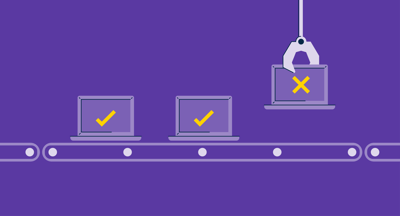
With more and more businesses employing rapid application development (RAD) workflows, switching to DevOps for operational efficiency has become a new norm. Now, more and more teams are strategizing on how to deploy DevOps to incorporate agile, lean and collaborative software collaboration to produce an application with minimal sweat and maximum efficiency.
By utilizing a DevOps software, you manage and monitor all stages of software production and optimize validation and testing without any manual intervention.
Ultimately, it leads to fewer exceptions, infections and bug crashes and optimizes the entire software development lifecycle process.
So, what exactly goes into the DevOps process to ensure consistent app quality and seamless automation?
Let's find out how DevOps merges two cornerstones of app production and centralizes testing, QA, versioning and more.
DevOps is a software development approach that combines development and IT operations to shorten the development lifecycle and continuously deliver high-quality software. It promotes automation, collaboration, and monitoring across all stages of software delivery, from integration and testing to deployment and maintenance.
DevOps breaks down work silos, syncs environments, and automates code processing—freeing up developer time and effort. Teams operate as a unified force, driving projects from concept to completion.
This collaboration spans the entire DevOps lifecycle, powered by Agile, Scrum, and CI/CD to accelerate development, streamline automation, and boost delivery speed.
DevOps isn’t a straight-line process, it’s a continuous loop of collaboration, feedback, and automation. Think of it as an infinite cycle where development and operations blend seamlessly, powered by DevOps software tools that automate, monitor, and improve every step.
Each phase of the DevOps lifecycle plays a unique role in delivering software that’s not just fast, but stable, secure, and scalable.
Let’s walk through the key stages:
Together, these stages power the core outcomes DevOps is known for—faster delivery, better reliability, higher scalability, and built-in security—making teams more adaptive and efficient.
DevSecOps ensures that security doesn't fall behind in the DevOps process. It blends "security" into every phase of the DevOps pipeline, shifting the responsibility from a final checkpoint to a shared, ongoing practice.
Instead of waiting until development to run security checks, teams using DevSecOps integrate them early, during code writing, building, testing and even deployment. This "shift-left" approach helps catch vulnerabilities sooner, reduces technical debt and creates even more resilient and robust software stack.
DevSecOps empowers teams to release software faster without trading off trust. It is especially valuable in regulated industries, where compliance is vital. It is also a trademark for companies managing cloud native applications in the following ways.
If you ever felt confused with terms like agile, scrum, DevOps, and CI/CD, you are not alone.
These concepts often overlap but serve different purposes in the software delivery ecosystem. Understanding how they work together (and where they don't) can help teams streamline processes, reduce friction, and improve outcomes.
| Concept | Focus | Scope | Key characteristic |
| Agile | iterative developments | Dev phase | Encourages rapid, incremental delivery through feedback loops and collaboration |
| Scrum | agile framework | Agile dev | Provides a structured method for Agile via roles, ceremonies, and sprint planning. |
| DevOps | collaboration and culture |
Full software lifecycle | Breaks down silos between dev and ops teams using automation, shared ownership and continuous feedback. |
| CI/CD | tool-driven automation | DevOps practice | Automates the flow from code commit to production with testing, validation, and deployment steps |
In plain language, Agile sets the development pace, Scrum puts Agile into practice, DevOps extends DevOps to production, and CI/CD delivers on DevOps automation processes.
All collaborative work environments come with challenges, but almost all DevOps teams agree that working under this process has a positive effect on their organization.
Here are some of the significant benefits that DevOps teams achieve, all of which lead to better quality applications, energized teams, and happier customers.
Even teams that embrace DevOps often encounter friction points. The key to long-term success isn't avoiding challenges; it's identifying and addressing them with the right strategies.
While DevOps teams need proper human intervention and frequent container monitoring to improve app utility in production, they also require substantial network infrastructure to detect and repair fault isolations and interface crashes, centralizing the backend operations and aiding in continuous production.
CI/CD stands for Continuous Integration and Continuous Delivery/Deployment, which enables consistent delivery of new feature releases. It’s a foundational DevOps practice that automates the process of building, testing, and releasing software in the following ways.
Automated processes are an essential part of successful DevOps. Teams can use continuous delivery software to release products to the market quickly and efficiently.
To be included in the continuous delivery software category, platforms must:
Below are the top five leading continuous delivery software solutions from G2’s Spring 2025 Grid® Report. Some reviews may be edited for clarity.
GitHub is a powerful development and project management tool that enables you to pull requests, repurpose coding scripts, save and store software projects, and collaborate in a multifaceted DevOps environment to optimize and automate CI/CD pipelines and push your stack to a live environment without glitches or bugs.
Trusted by millions, it streamlines code sharing, issue tracking, version control, and CI/CD integration, helping teams build and deploy software efficiently and securely.
"GitHub has great collaboration features that allow our development team to work on the same project together. From code reviews and discussions, it dramatically streamlines our ability to push great code to our customers. It also offers excellent version control through Git, keeping our team updated on code changes. It's easy to start with their free hosting, so it's a no-brainer for students wanting to learn to code."
- GitHub Review, Kyle J.
"With the easy access of Azure git within the Microsoft's azure environment, the GitHub has lost the charm though being a great git management tool."
- GitHub Review, Mohit K.
2. Salesforce Platform
Salesforce Platform is a unified ERP and software development kit (SDK) that helps you run your business workflows, control and host integrations for cloud native application and optimize your application development and testing operations all in a centralized environment.
It also enables you to get a harmonized view of your customer databases, automate coding with low-code/no-code editors and optimize your releases with increased efficiency and quality.
"Salesforce offers unmatched customization through its AppExchange, workflows, and automation tools. It's incredibly flexible and integrates well with external systems via APIs. The reporting and dashboard tools are also strong, enabling detailed performance tracking across teams."
- Salesforce Platform Review, Nabi R.
"As a user, what I don't like about Salesforce is that it is very expensive, especially for small businesses and startups, and as a developer, when you are dealing with a large amount of data, so the reports and dashboards can run slowly, and sometimes the governor limit can restrict the complex operation.
- Salesform Platform Review, Dhruv G.
GitLab offers an integrated development environment (IDE) to host, manage, monitor, plan, maintain, control and launch software projects with automated testing and DevOps processes.
With automated dashboards and CI/CD support, you can collaborate in a live environment, run compilation and execution, pull container registries, and deploy various agile techniques to shorten your time to deployment without extra network requirements or developer bandwidth.
"What I like most is that GitLab brings together version control, CI/CD, issue tracking, and project management in a single tool. I really like how seamless it is to go from writing code to deploying it, all without leaving the platform. The built-in CI/CD is easy to set up, and the merge request workflow helps keep code quality high."
- GitLab Review, Mohit V.
"Managing Gitlab runner infrastructure (especially for autoscaling or hybrid cloud environments) can be complex and will need close monitoring and resource Altering."
- GitLab Review, Sampath K.
LaunchDarkly is an AI-development and a feature management platform that helps plan, schedule and push releases in a timely manner. It allows teams to release risk, accelerate delivery and optimize feature rollouts through real-time feature flags.
It also offers advanced DevOps features like A/B testing, progressive rollouts, monitoring, and seamless CI/CD integration to optimize the quality and QA controls of your entire software development lifecycle process.
"LaunchDarkly has allowed us to deploy code into production on a regular basis and then enable release on demand to different segments of our customers (or all of them) on our schedule and not when the code is deployed. If something is wrong, instead of spending costly time rolling things back we can simply turn off the feature flag and hide the error from our customers and then fix it behind the scenes. This allow allows us to test it in production without impacting production. Highly recommend taking the steps needed to enable feature flags in your code and then utlizing LaunchDarkly to quickly manage who can see what in your applications."
- LaunchDarkly Review, Dwight S.
"It’s not easy to define custom metrics, especially when the denominator isn’t a simple user count. For example, setting up ratio-based metrics tied to events or domain-specific units (like entries or sessions) takes extra work and isn’t well-documented."
- LaunchDarkly Review, Vincent L.
Red Hat Ansible Automation Platform offers functionality for building, managing, controlling and securing cloud integrations.
A part of RedHat's primary enterprise automation offering, it automates ETL and data handling workflows and helps in continous integration and continuous delivery (CI/CD) operations to regularize the software development lifecycle and make your product more efficient and user friendly.
"AAP makes my life easier because I am a lazy engineer! If there is ever a configuration task that I have to do more than once, I use AAP to get it done. Even if I may only do something once, chances are there is a playbook for it, just incase I ever have to do it again."
- Red Hat Ansible Automation Platform, Dave K.
"Cost is definitely a thing that can be off putting with moving towards the GUI offering (as well as other associated features that come with it)."
- Red Hat Ansible Automation Platform, Carson M.
Working under a DevOps process encourages and fosters a collective spirit within development teams, which leads to incredible outcomes and improves the quality of the software stack. When multiple teams take up a share in the software development lifecycles, employ robust agile, scrum and CI/CD workflows, and streamline testing, it caters to faster production, delivery, and quality of software applications and makes them fit for customer deployment.
By introducing DevOps software within your development teams, you can not only help them optimize their bandwidth, but also automate processes like API management or versioning and testing to push upgrades and invest in a reliable and secure goal.
Build applications faster with low-code development platforms designed to get your software to market as quickly as possible.
This article was originally published in 2024. It has been updated with new information.
Holly Landis is a freelance writer for G2. She also specializes in being a digital marketing consultant, focusing in on-page SEO, copy, and content writing. She works with SMEs and creative businesses that want to be more intentional with their digital strategies and grow organically on channels they own. As a Brit now living in the USA, you'll usually find her drinking copious amounts of tea in her cherished Anne Boleyn mug while watching endless reruns of Parks and Rec.
We presume writing and compiling software programs is easy. But it's not.
.png) by Shreya Mattoo
by Shreya Mattoo
Software update pop-ups always seem to appear at the worst possible time. I’ve lost count of...
 by Harshita Tewari
by Harshita Tewari
Software is eating the world.
 by Dibyani Das
by Dibyani Das
We presume writing and compiling software programs is easy. But it's not.
.png) by Shreya Mattoo
by Shreya Mattoo
Software update pop-ups always seem to appear at the worst possible time. I’ve lost count of...
 by Harshita Tewari
by Harshita Tewari


